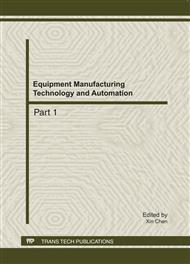[1]
Zhibin Jiang, Zongwu Hu. The new model of manufacturing systems[J]. Industrial Engineering and Management.2002, No.2:1-7;(In Chinese)
Google Scholar
[2]
Hanmin Shi. From his organization go towards the organization—about manufacturing philosophy of meditation [J]. Chinese Mechanical Engineering. 2000.2,vol.11,No.122:80—85; (In Chinese)
Google Scholar
[3]
Bo-peng Zhang, Dengwen Yu. The evolution of manufacturing engineering[J].Chinese Mechanical Engineering, 2008.1,vol.19,No.2:178-182; (In Chinese)
Google Scholar
[4]
ChengMing, Jianyong Li, Jianzhong Cha, Yuefa Fang. Intelligent Manufacturing Systems Self-Organization cell structure research[J]. Journal of Northern Jiaotong University, Aug.2000,Vol.24,No.4:47-51(In Chinese)
Google Scholar
[5]
Frei,R.; Di Marzo Serugendo, G.; Barata, J. Designing self-organization for evolvable assembly systems[C], Second IEEE International Conference on Self-Adaptive and Self-Organizing Systems (SASO), 2008, 97-106.
DOI: 10.1109/saso.2008.20
Google Scholar
[6]
Frei,Regina; Barata, Jose;Onori, Mauro Evolvable production systems context and implications[J], 2007 IEEE International Symposium on Industrial Electronics, ISIE 2007, Proceedings, 2007, 3233-3238
DOI: 10.1109/isie.2007.4375132
Google Scholar
[7]
Shin, M. Cha, Y.; Ryu, K.; Jung, M. Conflict detection and resolution for goal formation in the fractal manufacturing system[J], International Journal of Production Research, v 44, n 3, Feb 1, 2006, 447-465.
DOI: 10.1080/00207540500142845
Google Scholar
[8]
Xiao-hua Zhang; Wei Chen; Yan-mingSun; Shi-xiong Zheng. The overview of fractal theory and its application in manufacturing system[J]. Manufacturing Automation. vol 29, 2009,No.3:pp.4-9. (In Chinese)
Google Scholar
[9]
Quanxi Li; Xiaomiao Ma, Infiltration mechanism and strategies of TPS culture based on self-organization theory[C], MANUFACTURING AUTOMATION, 2008, 4. (In Chinese)
Google Scholar
[10]
Guotao Ji, Qingshan Zhang. About enterprise organization and environmental adaptive thinking[J]. SCIENCE AND TECHNOLOGY MANAGEMENT RESEARCH,1999,4:8-10; (In Chinese)
Google Scholar


